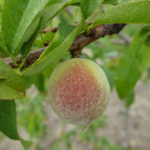The Office of the Indiana State Chemist has filed a Notice of Intent to Adopt a New Rule that will make most dicamba containing herbicides Restricted Use Products (RUP). This designation will allow the OISC to track sales of those herbicides. As many specialty crop growers know, dicamba is one of the growth regulator herbicides[Read More…]
Crop Management
Tipping of primocanes (new vegetative canes from the ground) is an important management practice for summer bearing blackberries and black raspberries. Tipping the new primocanes causes lateral branching and most of the fruit production next year will be from buds on those lateral branches rather than buds off the main cane. Tipping also helps increase[Read More…]
Growers across the state experienced some damage from frost and freeze events on May 7, 8, and 9. Damage is scattered across the state and ranges from minor to severe. We did not have damage in the Lafayette area, but areas of northern and northeastern Indiana were hit. Surprisingly some damage occurred in south central[Read More…]
Remember that many chemical thinners don’t work very well when daily temperatures are below about 65 F. So here we are with warm days ahead, which means rapid fruit growth, perhaps up to 1 mm per day. Apple fruit here in Lafayette are about 12mm which leaves us some good options for chemical thinning. However[Read More…]
What an unusual spring it’s been. We started out extremely early, then it was cool for a month or so with hardly any Growing Degree Day accumulation, then warm again (see Figure 1). Just when apple crops started to get in the window for chemical thinning (around 12 mm), it became cool again. The good[Read More…]
Grapes are at the 8-10 inch shoot stage in southern Indiana and 6 inches or less in northern Indiana. Brambles are blooming in the south and approaching first bloom in central and northern areas. Blueberries are at petal fall to full bloom across the state. There are a few reports of damage to grapes and[Read More…]
One of the most critical management practices for grapes is crop load management through shoot and cluster thinning. Many varieties grown in Indiana tend to produce a large number of “non-count” shoots from adventitious buds and basal buds at count nodes. This can lead to excess crop and shading in the canopy. In addition, some[Read More…]
The recent spate of cool, wet weather has left one organism happy, Venturia inaequalis, the fungus that causes apple scab. Most of the state just underwent an extreme scab period, and unfortunately, few of us could do anything about it because of the combination of rain and wind. The revised Mill’s table (from http://www.fruit.cornell.edu/tfabp/revmills.htm )identifies[Read More…]
Grapes have grown quickly this past week and most varieties are now past bud burst. The earliest have 4 to 6 inch shoots at this time. Blackberries and raspberries are also growing rapidly, with new primocanes emerging from the ground and laterals on floricanes out to 4 inches or longer. Flower buds are visible on[Read More…]







